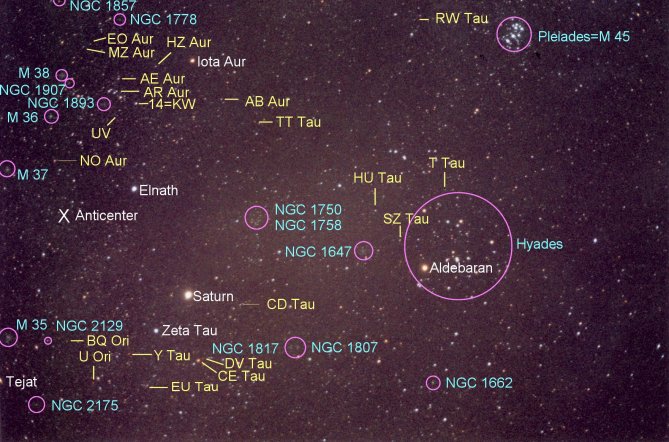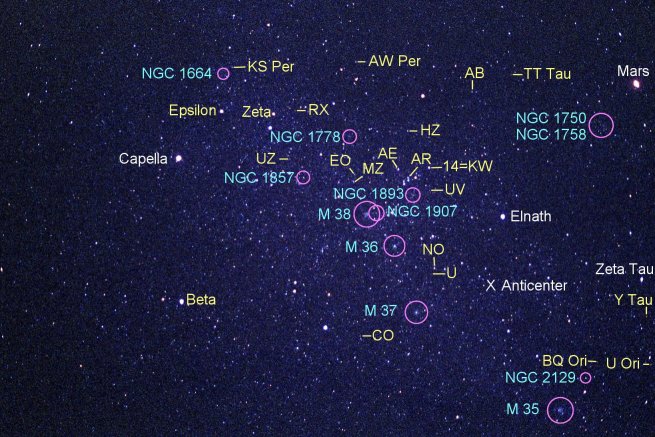THE ANTICENTER OF THE GALAXY (original) (raw)
THROUGH TAURUS AND AURIGA
Their Clusters, Variables, and Dark Clouds
The Earth and Sun are roughly two- thirds of the way from the center of our Galaxy to a vaguely defined edge. Towards the Galactic Center in Sagittarius, the [Milky Way](sgrwide-** **p.html) is thus broad and thick, while in the other direction, 180 degrees away, toward the Anticenter at the border between Taurus and Auriga (whose images are shown below), we look through a far-thinner blanket of stars, rendering the Milky Way faint and harder to distinguish. Pieces of [Gemini](gemini-** **p.html), Orion, and Perseus appear around the fringes of the images.
### Compare with the view of the Galactic Center and its Messier objects.
---
### TAURUS AND SOUTHERN AURIGA
#### (North is up and to the left.)

See the: *** full resolution version;** *** full-resolution unlabelled image;** *** associated article Through Taurus to the Anticenter in the February 2005 Sky and Telescope, p. 91;** *** Cambridge Encyclopedia of Stars.**
---
### AURIGA
#### (North is to the left.)

See the: *** full resolution version;** *** full-resolution unlabelled image;** The region around the often-neglected Anticenter (the white "X: in each of the images) is nevertheless rich in open clusters (purple circles with blue labels) and variable stars (yellow labels). In the image of Taurus, they outline a large blank area to the left of center, the Taurus-Auriga dark cloud, a complex of dusty molecule-filled star-forming clouds 460 light years away that block the light of the more-distant background. Two of the open clusters (the [Hyades](hyades-** **p.html) and Pleiades) are readily visible to the naked eye. In the Auriga image, the clusters and variables strongly track the faint Milky Way from upper left to lower right, the dark clouds now off to the right.
OPEN CLUSTER PROPERTIES
The following table gives the properties of the open clusters identified in the above images. In horizontal order the table presents:
- NAME: Catalogue number (NGC = New General Catalogue; IC = Index Catalogue) or popular name;
- MESS: Messier number from the catalogue of Charles Messier;
- CONST: Constellation of residence;
- DIST: Distance in light years;
- ABS: Interstellar dust absorption in visual magnitudes;
- DIAM (min): Diameter in minutes of arc;
- DIAM (ly): Diameter in light years;
- AGE: Age in millions of years;
- REMARKS. Note:
- Single (*) and double (**) asterisks in the NAME column denote variables respectively visible only on the Taurus or Auriga images. Others are seen in both.
- Clusters fall away gradually to an ill-defined fuzzy "edge." Cluster "diameter" thus depends on exposure time and the exact definition, and is meant only as an approximate guide. Ages are also approximate.
| NAME | MESS | CONST | DIST | ABS | DIAM (min) | DIAM (ly) | AGE | REMARKS |
|---|---|---|---|---|---|---|---|---|
| Pleiades | M 45 | Tau* | 425 | 0.13 | 110 | 14 | 130 | Seven Sisters; enmeshed in nebula |
| Hyades | ... | Tau* | 151 | 0.03 | 330 | 15 | 650 | Aldebaran in foreground; nearest large cluster |
| NGC 1647 | ... | Tau* | 1770 | 0.93 | 40 | 21 | 140 | ... |
| NGC 1662 | ... | Ori* | 1350 | 1.09 | 11 | 15 | 300 | ... |
| NGC 1664 | ... | Aur** | 3900 | 0.25 | 18 | 20 | 300 | "Kite Cluster" |
| NGC 1750 | ... | Tau | 2050 | 1.08 | 10 | 60 | 200 | With NGC 1758 called NGC 1746 |
| NGC 1758 | ... | Tau | 2500 | 1.08 | 7 | 50 | 400 | With NGC 1750 called NGC 1746 |
| NGC 1778 | ... | Aur | 4800 | 1.09 | 7 | 10 | 110 | ... |
| NGC 1807 | ... | Tau* | ... | ... | 12 | ... | ... | ... |
| NGC 1817 | ... | Tau* | 5400 | 1.06 | 20 | 31 | 630 | ... |
| NGC 1857 | ... | Aur | ... | 2.2 | 10 | ... | 180 | ... |
| NGC 1893 | ... | Aur | 12,600 | 1.57 | 25 | 90 | 10 | With nebula IC 410 |
| NGC 1907 | ... | Aur | 4800 | 1.38 | 5 | 7 | 400 | ... |
| NGC 1912 | M 38 | Aur | 3640 | 0.83 | 14 | 15 | 300 | ... |
| NGC 1960 | M 36 | Aur | 4200 | 0.70 | 12 | 15 | 32 | ... |
| NGC 2099 | M 37 | Aur | 4900 | 0.90 | 26 | 37 | 400 | ... |
| NGC 2129 | ... | Gem | 5000 | 2.3 | 52 | 7 | 10 | May not exist |
| NGC 2168 | M 35 | Gem | 2700 | 0.80 | 28 | 22 | 200 | ... |
| NGC 2175 | ... | Ori* | 7200 | 3 | 5 | 10 | 1 | With nebula S 252 |
VARIABLE STAR PROPERTIES
The following table gives the properties of the variable stars identified in the above images. In horizontal order the table presents:
- NAME: Variable-star or proper name in traditional order;
- VAR CLASS: Variable star class, whether:
- eclipsing binary;
- Mira (long-period) variable;
- semi-regular variable;
- irregular variable
- Cepheid variable;
- RV Tauri star (low-mass pulsators related to Cepheids)
- Beta Cephei star;
- Delta Scuti star;
- Alpha-2 Canum Venaticorum star (magnetic variable).
- SPECT CLASS: Spectral class, including the Roman numeral luminosity class;
- MAG: Magnitude range (visual);
- PERIOD: Variable period in days;
- DIST: Distance in light years, where "p," "s," and "c," denote distances from parallax, spectral class, and Cepheid period-luminosity relation (allowing for interstellar absorption);
- REMARKS. Note:
- Distances from spectral class are very uncertain;
- Single (*) and double (**) asterisks in the NAME column denote variables respectively visible only on the Taurus or Auriga images. Others are seen in both.
| NAME | VAR CLASS | SPECT CLASS | MAG | PERIOD | DIST | REMARKS |
|---|---|---|---|---|---|---|
| Beta Aur** | Ecl binary | A2 IV | 1.9-2.0 | 3.96 | 82p | Menkalinan |
| Epsilon Aur** | Ecl binary | F0 I | 3.0-3.8 | 9890 | 2000p | Almaaz; huge dust ring |
| Zeta Aur** | Ecl binary | K4 II+B8 V | 3.8-3.9 | 972 | 850p | Haedus I |
| U Aur** | Mira | M9 III | 8-14 | 370 | 3000s | ... |
| RX Aur** | Cepheid | G0 Iab | 7.3-8.2 | 11.62 | 6000c | Dist from P-L relation |
| UV Aur | Mira | C II | 8-11 | 393 | 3500?s | carbon star |
| UZ Aur* | Semi-regular | M3.5 III | 8.7-9.9 | 65 | 1000p | ... |
| AB Aur | Ae/Be protostar | A0pe | 7-7.1 | Irreg | 455p | Still in formation |
| AE Aur | Irreg | O9.5ve | 6-6.1 | ... | 1460p | With Mu Col, runaway star |
| AR Aur | Ecl binary | B9.5 V | 6.1-6.7 | 4.13 | 400p | 17 Aur |
| CO Aur** | RV Tauri | F5 Ib | 7.4-8.6 | 40 | 6600s | Low mass "Cepheid" |
| EO Aur | Ecl binary | B5 | 7.7-8.2 | 4.07 | 1200p | ... |
| HZ Aur | Magnetic peculiar | B9p | 7-7.1 | 6.43 | 510p | Magnetic spots; period is rotation period |
| KW Aur | Delta Scuti | A9 IV | 4.9-5.1 | 0.08809 | 269p | 14 Aur; quintuple with [white dwarf](star%5Fintro.html#white dwarfs) |
| MZ Aur | Beta Cep star | B1.5 Ivp | 8.1-8.3 | Multiple | 4600s | ... |
| NO Aur | Irregular | M2 III S | 6.1-6.3 | Irreg | 1400p | Incipient class S carbon star |
| U Ori | Mira | M8 III | 6-12 | 373 | 1200s | ... |
| BQ Ori | Semi-regular | M5 III | 7.1-8.0 | ... | 800 | ... |
| AW Per** | Cepheid | F6 I | 7.5-8.2 | 6.463 | 3500c | ... |
| KS Per** | Semi-regular | A5 Ia | 7.6-7.8 | 35? | 2800s | Bidelman's star; extreme hydrogen deficiency |
| T Tau* | Protostar | G5 Ve | 9-11 | Irreg | 575p | Multiple star still in formation |
| Y Tau* | Semi-regular | C5 II | 6-8 | 241 | 900p | Carbon star |
| SZ Tau* | Cepheid | F7 Ib | 6.5-6.8 | 3.15 | 1050p | ... |
| TT Tau | Semi-regular | C5 II | 8-9 | 166 | 3000s | Carbon star |
| CD Tau* | Ecl binary | F7 V | 6.8-7.3 | 3.44 | 240p | ... |
| CE Tau* | Semi-regular | M2 Iab | 4.2-4.5 | 165 | 1900?p | 119 Tauri; carbon star |
| DV Tau* | Irreg | M6? | 8-9 | ... | 4000s | ... |
| EU Tau* | Cepheid | G5 | 8.1-8.4 | 2.10 | 4000c | ... |
| HU Tau* | Ecl binary | B8 V | 5.9-6.7 | 2.06 | 360p | Total eclipse |
